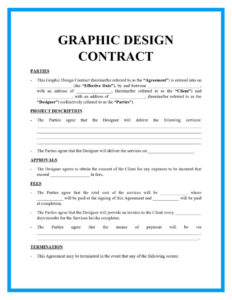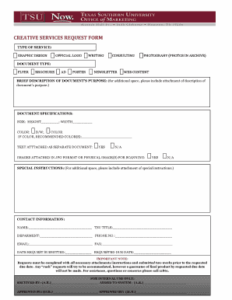Venturing into the world of graphic design, whether you’re a seasoned freelancer or just starting your own studio, is incredibly exciting. You get to bring visions to life, craft stunning visuals, and help businesses tell their stories. However, amidst all that creative energy, it’s easy to overlook one of the most crucial tools for a smooth and successful project: a solid agreement. Without clear boundaries and expectations, even the most promising collaborations can quickly turn sour, leading to misunderstandings, unpaid invoices, and ultimately, a lot of unnecessary stress.
That’s where a well-crafted graphic design work contract template comes into play. Think of it as your professional shield, protecting both you and your client by clearly outlining the terms of your engagement. It’s not about being distrustful; it’s about being professional, transparent, and ensuring everyone is on the same page from day one. A comprehensive contract sets the foundation for a positive working relationship, minimizes potential disputes, and ensures you get paid for your brilliant work.
What Essential Elements Should Your Graphic Design Contract Cover?
Crafting a robust graphic design contract doesn’t have to be a daunting task. The key is to be thorough and cover all the bases that might arise during a project. A great contract acts as a reference point for both parties, answering questions before they even become problems. It outlines the what, when, why, and how of your design process, ensuring clarity and accountability throughout the entire project lifecycle.
Defining the Project Scope and Deliverables
This is arguably the most critical section. You need to clearly articulate what design services you’ll be providing and, just as importantly, what you won’t be doing. Vagueness here is a recipe for scope creep, where small additional requests snowball into a much larger project than initially agreed upon. Detail the specific deliverables, such as logo files, website mockups, print-ready documents, and the formats they will be provided in. Specify the number of design concepts and revisions included in the initial fee, and what constitutes additional charges for further changes.
Understanding Payment Terms and Schedules
Money matters can be awkward, but a contract makes them crystal clear. This section should detail your total project fee, any upfront deposits required, and the schedule for subsequent payments. Many designers opt for a deposit upfront, with milestone payments throughout the project, and a final payment upon completion and approval of the deliverables. Don’s forget to include provisions for late payment penalties to encourage timely compensation for your hard work.
* Upfront deposit percentage
* Payment schedule for key project milestones
* Final payment upon project completion and client approval
* Late payment penalties and interest rates
* Refund policies, if applicable
Revisions, Approvals, and Communication
How many rounds of revisions are included in the price? What is the turnaround time for those revisions? How will the client approve designs at various stages? This section lays out the communication protocol. It should specify the number of revision rounds included in the initial fee and clarify that additional revisions will incur extra charges. Define the method of communication, whether it’s email, a project management tool, or scheduled calls, to ensure a smooth flow of feedback and approvals. This helps manage client expectations and keeps the project moving forward efficiently.
Protecting Your Creative Work and Business Interests
Beyond the project specifics, a strong graphic design work contract template also serves as a crucial legal document safeguarding your business and intellectual property. It’s about more than just getting paid; it’s about defining ownership, privacy, and how disputes will be resolved, ensuring that your creative assets are protected.
Intellectual property rights are paramount in creative fields. Your contract should explicitly state when and how the client gains ownership of the final design files. Typically, you retain ownership of all preliminary sketches, concepts, and working files, while the client receives usage rights or full ownership of the final approved deliverables upon final payment. Clearly defining this prevents future disagreements over who owns what and how the designs can be used.
Confidentiality is another vital component, especially when working with sensitive client information or unreleased products. Including a nondisclosure clause ensures that both parties agree to keep certain information private. This protects your client’s business secrets and your own proprietary processes or internal design strategies. It fosters trust and professionalism, showing that you value the security of their information.
It’s also wise to include clauses for project termination and dispute resolution. While everyone hopes for a smooth project, sometimes things don’t go as planned. A termination clause outlines the conditions under which either party can end the agreement, including any associated fees or payment for work completed up to that point. A dispute resolution clause can specify how disagreements will be handled, whether through mediation or arbitration, before resorting to more costly litigation.
* Intellectual Property Rights: Clearly stating who owns the final artwork and any preliminary designs, and when ownership transfers.
* Confidentiality: Ensuring sensitive project information shared by either party remains private and protected.
* Termination Clauses: Outlining conditions for ending the agreement and associated fees or payment for completed work.
* Dispute Resolution: Specifying the preferred method for resolving disagreements, such as mediation or arbitration.
Ultimately, investing time in creating or adapting a robust graphic design work contract template is one of the smartest decisions you can make for your creative business. It elevates your professionalism, builds trust with your clients, and provides a clear roadmap for every project, from concept to completion. By setting clear expectations upfront, you create a harmonious working environment where creativity can flourish without the looming shadow of potential conflict.
So, take the initiative to equip your design business with this essential tool. A well-defined contract isn’t just a legal formality; it’s a testament to your commitment to excellence, clear communication, and the smooth execution of every graphic design endeavor you undertake. It offers peace of mind, allowing you to focus on what you do best: creating stunning visual experiences.



